Spišská Kapitula
Spišská Kapitula (Hungarian: Szepeshely or Szepesi Káptalan) (both meaning the "Spiš Chapter house") is an exceptionally well-preserved ecclesiastical town on the outskirts of Spišské Podhradie, Slovakia, and overlooking Spiš Castle. It is part of the UNESCO World Heritage site "Levoča, Spiš Castle and the associated cultural monuments".[1]
Spišská Kapitula | |
|---|---|
Ecclesiastical Town | |
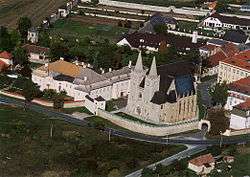 View of Spišská Kapitula from above | |
_-_physical_map.png) Spišská Kapitula Location of Spišská Kapitula in the Western part of the Prešov Region  Spišská Kapitula Spišská Kapitula (Slovakia) | |
| Coordinates: 49°00′N 20°45′E | |
| Country | Slovakia |
| Region | Prešov |
| District | Levoča |
| Municipality | Spišské Podhradie |
| UNESCO World Heritage Site | |
|---|---|
| Official name | Levoča, Spiš Castle and the associated cultural monuments |
| Criteria | iv |
| Reference | 620 |
| Inscription | 1993 (17th session) |
The town consists of St. Martin's Cathedral (dedicated to St. Martin of Tours), a former monastery, and a single street, all of mediaeval construction and enclosed by a wall. The lower gate gives an extensive view of Spiš Castle, located on an opposite hill. Spišská Kapitula became the main seat of the church administration in the region in the 12th century. In 1776 it became the seat of the Diocese of Spiš (Szepes). The present bishop, the 14th, is Mgr. Štefan Sečka.
Town and history
The town consists of St. Martin's Cathedral (dedicated to St. Martin of Tours); a former monastery; and a single street, all of mediaeval construction and enclosed by a wall. The lower gate gives an extensive view of Spiš Castle, located on an opposite hill.
Spišská Kapitula became the main seat of the church administration in the region in the 12th century. In 1776 it became the seat of the Diocese of Spiš (Szepes). The present bishop, the 14th, is Mgr. Štefan Sečka.
The cathedral was built between the 13th and 15th centuries in the Romanesque and Gothic styles. It is one of the largest and most interesting Romanesque monuments in Slovakia. It contains many mediaeval carved altars and is the resting place of many lords of Spiš Castle; the 15th century carved marble tombstones of the Zápoľský family are of exceptional quality. A recently restored wall-painting from 1317 depicts the coronation of Charles Robert of Anjou as the King of Hungary; another painting in the cathedral is the source for the provisional name of the anonymous Master of Kirchdrauf.
Spišská Kapitula was visited by Pope John Paul II in 1995.
St. Martin's Cathedral
St. Martin's Cathedral, the Romanesque Catholic cathedral in Spišská Kapitula is a local part of the town Spišské Podhradie in the district of Levoča. It is also the parochial church. It is a Romanesque-Gothic cathedral, built in the first third of the 13th century pseudo-basilica with a central nave, two aisles and one transept. In 2003, the remains of Bishop Ján Vojtašák (1877-1965) were deposited in the cathedral.
It is one of the largest and most interesting Romanesque monuments in Slovakia. It contains many medieval carved altars and is the resting place of many lords of Spiš Castle; the 15th century carved marble tombstones of the Zápoľský family are of exceptional quality. A recently restored wall-painting from 1317 depicts the coronation of Charles Robert of Anjou as the King of Hungary; another painting in the cathedral is the source for the provisional name of the anonymous Master of Kirchdrauf (the former name of Spišské Podhradie).
Spišská Kapitula became the main seat of the church administration in the region in the 12th century. In 1776 it became the seat of the Diocese of Spiš, after Hungarian queen Maria Theresa split the Diocese of Eger (now Archidiocese of Eger). The Cathedral is one of the most valuable examples of Late-Gothic and Gothic architecture in Slovakia.
Images
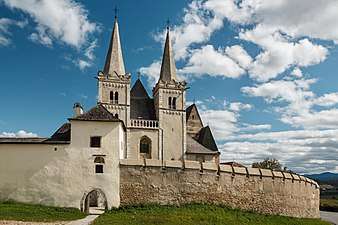 Spišská kapitula
Spišská kapitula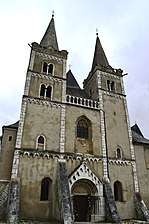 Spišská Kapitula - St. Martin's cathedral
Spišská Kapitula - St. Martin's cathedral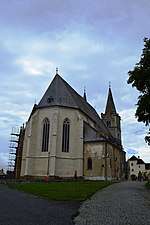 Spisska Kapitula - Cathedral apse
Spisska Kapitula - Cathedral apse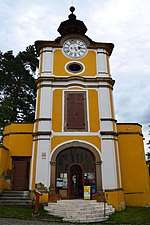 Spišská Kapitula - Bell tower
Spišská Kapitula - Bell tower- View from Spiš Castle
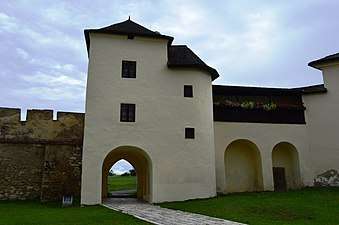 Spišská Kapitula - gateway
Spišská Kapitula - gateway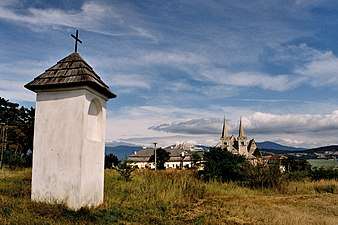 Spišská Kapitula
Spišská Kapitula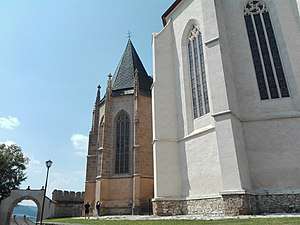 Spišská Kapitula
Spišská Kapitula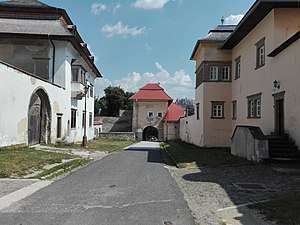 Spišská Kapitula Main Street
Spišská Kapitula Main Street
References
Citations
- "Levoča, Spiš Castle and associated cultural monuments". UNESCO World Heritage Centre. Retrieved 2018-06-28.
General references
- Horváth, Tibor (1999). Szlovákia (in Hungarian) (1st ed.). Budapest: Cartographia. ISBN 963-353-180-2.
- Gabor Méry, Marcell Jankovics - St. Martin's Cathedral Spišská Kapitula (2013), Šamorín (Somorja) ISBN 978-80-8160-018-0
- Vladimír Olejník, Ľubica Olejníková - Katedrála sv. Martina v Spišskej Kapitule (2017), Spišské Podhradie: Rímskokatolícka cirkev Biskupstvo Spišské Podhradie ISBN 978-80-971341-5-0
- https://www.spisskyhrad.com/lokalita/spisska-kapitula/
- http://apsida.sk/c/3195/spisska-kapitula
- https://www.unesconadosah.sk/en/location/spisska-kapitula-spis-chapter
.jpg)